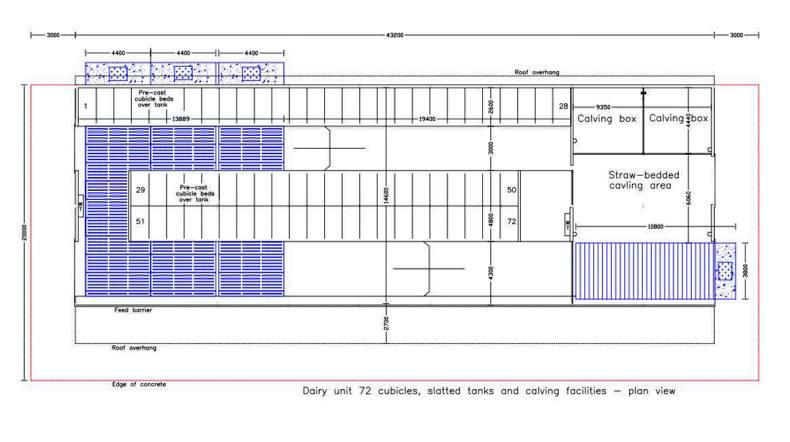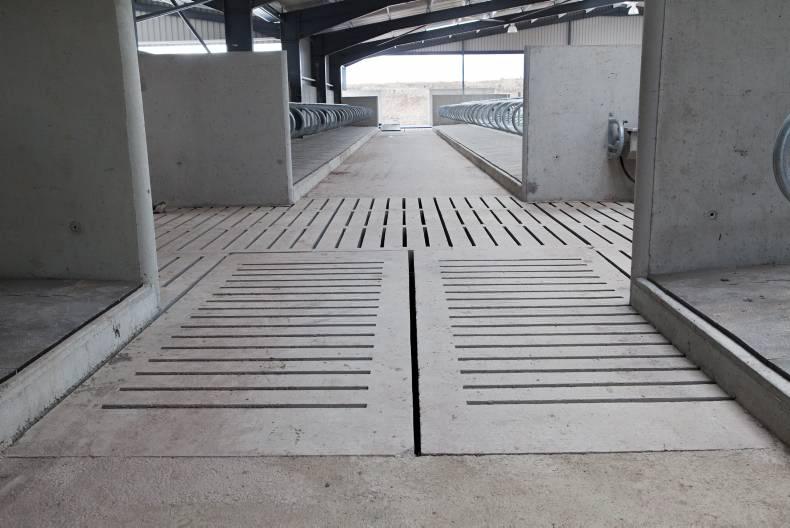Cubicle housing is likely to be a popular investment option for expanding dairy farms in the next few years of the TAMS II schemes. In this example we give an itemised cost (Table 1) for a 72-cow dairy unit with calving facilities based on the dimensions of the accompanying drawing.
In total, this unit would cost €176,005 excluding VAT. A successful solo Young Farmer Capital Investment Scheme (YFCIS) applicant could get a maximum grant of €48,000 towards the building work. If two young farmers qualified for the YFCIS and were in a partnership, they could get a maximum grant of up to €96,000 towards the costs. If only one farmer in a partnership qualified for the YFCIS, the partners could still apply through the YFCIS where they could get a maximum grant of €80,000.
Non-qualifying YFCIS could apply for grant aid through the Animal Welfare, Safety and Nutrient Storage Scheme where in this example they could get a maximum grant of €32,000 towards the costs for a successful application. Two non-qualifying YFCIS could get a maximum grant of €64,000 towards the costs for successful application.
Main specifications
The specifications for livestock units are listed on the Department’s website under S123. In order to ensure a stress-free environment for dairy cows in houses with double or multiple rows of cubicles, the following must be incorporated in the layout of any new buildings according to the Department:
At least two routes to the feed face.No dead-end passagesCrossover points between rows must be a minimum of 2.3m (two cubicles) wide, or 3.5m (three cubicles) wide if a drinker is positioned at the point.In all cubicle houses there must be a minimum 3.5m standing area at the feed face, and at least two drinkers, per 50 cubicle unit.
It is recommended that where the heel of the cubicle bed faces the feed face that the standing area be at least 4m wide. Solid-floor cubicle houses must normally incorporate an easy-feed passage with barriers. If a self-feed design is chosen the Department strongly recommend that all feeding areas be covered to minimise requirements for soiled water storage.

Scraped passages behind cubicle beds must be at least 1.8m wide, and normally 2m or more. It is recommended that the passages be 2.7m wide. Channels to which slurry is scraped must have slatted or gridded covers with maximum 40mm slots, or alternatively be positioned to prevent any animal access.
Mechanical scrapers must be installed to manufacturer’s specifications. For smaller cubicle units (no more than eight cubicles on any side of each passage) where the cubicle beds run perpendicular to the feed passage, the requirement for crossover points and no dead-end passages is relaxed to a strong recommendation.
Where there are more than eight cubicles, crossover points must be installed. Existing cubicle housing may be adapted by the provision of creep area and an easy feed arrangement.
Where a slatted feed area is being added on to an existing cubicle house, the Department strongly recommends that the cubicle house layout is adjusted, if necessary, to meet the above requirements.
To read the full Buildings and TAMS II Focus supplement, click here.
Cubicle housing is likely to be a popular investment option for expanding dairy farms in the next few years of the TAMS II schemes. In this example we give an itemised cost (Table 1) for a 72-cow dairy unit with calving facilities based on the dimensions of the accompanying drawing.
In total, this unit would cost €176,005 excluding VAT. A successful solo Young Farmer Capital Investment Scheme (YFCIS) applicant could get a maximum grant of €48,000 towards the building work. If two young farmers qualified for the YFCIS and were in a partnership, they could get a maximum grant of up to €96,000 towards the costs. If only one farmer in a partnership qualified for the YFCIS, the partners could still apply through the YFCIS where they could get a maximum grant of €80,000.
Non-qualifying YFCIS could apply for grant aid through the Animal Welfare, Safety and Nutrient Storage Scheme where in this example they could get a maximum grant of €32,000 towards the costs for a successful application. Two non-qualifying YFCIS could get a maximum grant of €64,000 towards the costs for successful application.
Main specifications
The specifications for livestock units are listed on the Department’s website under S123. In order to ensure a stress-free environment for dairy cows in houses with double or multiple rows of cubicles, the following must be incorporated in the layout of any new buildings according to the Department:
At least two routes to the feed face.No dead-end passagesCrossover points between rows must be a minimum of 2.3m (two cubicles) wide, or 3.5m (three cubicles) wide if a drinker is positioned at the point.In all cubicle houses there must be a minimum 3.5m standing area at the feed face, and at least two drinkers, per 50 cubicle unit.
It is recommended that where the heel of the cubicle bed faces the feed face that the standing area be at least 4m wide. Solid-floor cubicle houses must normally incorporate an easy-feed passage with barriers. If a self-feed design is chosen the Department strongly recommend that all feeding areas be covered to minimise requirements for soiled water storage.

Scraped passages behind cubicle beds must be at least 1.8m wide, and normally 2m or more. It is recommended that the passages be 2.7m wide. Channels to which slurry is scraped must have slatted or gridded covers with maximum 40mm slots, or alternatively be positioned to prevent any animal access.
Mechanical scrapers must be installed to manufacturer’s specifications. For smaller cubicle units (no more than eight cubicles on any side of each passage) where the cubicle beds run perpendicular to the feed passage, the requirement for crossover points and no dead-end passages is relaxed to a strong recommendation.
Where there are more than eight cubicles, crossover points must be installed. Existing cubicle housing may be adapted by the provision of creep area and an easy feed arrangement.
Where a slatted feed area is being added on to an existing cubicle house, the Department strongly recommends that the cubicle house layout is adjusted, if necessary, to meet the above requirements.
To read the full Buildings and TAMS II Focus supplement, click here.







 This is a subscriber-only article
This is a subscriber-only article











SHARING OPTIONS: